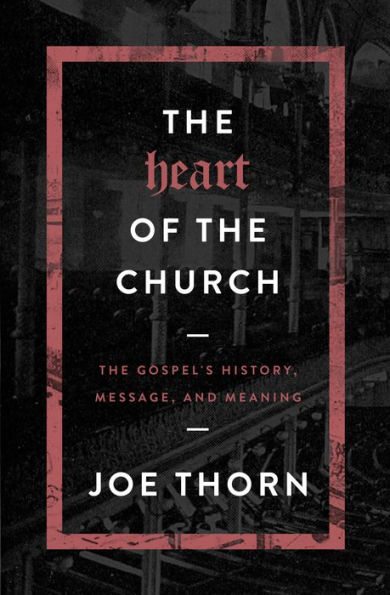Go-to books are hard to come by. I’m talking about books that are the perfect resource when someone asks you a question. You can hand them a copy and say, “Trust me; read this.”
Joe Thorn’s series on the church is in the go-to category for questions about the church.
Thorn is the lead pastor of Redeemer Fellowship in St. Charles, Illinois. I’ve been using a few of his articles in our church’s internship program for years, so when I heard he wrote a series of books about the church, I was eager to read them. So Josh (one of our elders), Patrick (counselor and church member), Jon (engineer and church member), and I spent a few days reading and discussing them. What follows is a summary of our take on the books.
What’s in the Series
Thorn’s work is arranged in three short books that build on one another.

The Heart of the Church: The Gospel’s History, Message, and Meaning
Joe Thorn
The Heart of the Church: The Gospel’s History, Message, and Meaning
Joe Thorn
Book 1 — The Heart of the Church: The Gospel’s History, Message, and Meaning
The good news of the gospel is the truth that shapes a church’s identity and mission. Book 1 helps the reader understand how grand doctrines like justification, forgiveness, conversion, reconciliation, sanctification, election, and regeneration affect believers and bring them into the body of Christ. Getting the gospel right is essential because “if the gospel is not the heart of a local church, then something else will be” (105). This book roots believers in the historical truth of God’s work for us in Christ.
Book 2 — The Character of the Church: The Marks of God’s Obedient People
The Word of God unifies the church around what Thorn describes as five essentials:
- The Bible rightly preached,
- Baptism and the Lord’s Supper rightly administered,
- Formed and functioning church leadership,
- The exercising of church discipline, and
- A clear focus and obedience to the mission that Jesus prescribed.
These non-negotiable marks make clear what the church is and determines what the church does (10). This book is packed full of explanation about what makes the church a Christ-filled light to the watching world.
Book 3 — The Life of the Church: The Table, Pulpit, and Square
How the new community lives, worships, and goes on mission together is essential to understanding how we’re to be disciples who make disciples. To help simplify this complex pursuit, Thorn encourages us to “think of church life . . . as encompassed in three environments . . . the table, the pulpit, and the square” (13). The table refers to the fellowship of the church carried out in small gatherings that emphasize community. The pulpit is the church led by God’s Word when they gather for corporate worship. The square describes how the church should intentionally engage in the culture to make Christ’s name known. He concludes, “The more organized and focused a church is in these three environments, the more fruitful, steady, and healthy it becomes” (105).
The three-book design runs the risk of readers missing out on key elements if they skip an installment, but in the end I appreciated the design. I’m the kind of reader who likes to feel I’m making progress. Short chapters and a quick page-turning pace make for enjoyable reading. This series fits that description perfectly.
Strengths of the Series
1. Simple, Clear, Deep
Thorn has a way of making deep truths accessible without compromising precision or clarity. His definitions throughout the books make grand concepts seem simple but not simplistic. He “put the cookies on the bottom shelf,” as Howard Hendricks used to say.
This kind of writing is important in theological circles. Too many readers are scared off when they begin wading into the deep waters of soteriology, ecclesiology, and missiology. But Thorn concisely explains these ideas in a way new believers can grasp and church elders can be challenged by. Josh and I both loved the way he crystalized the purpose of the church (to make disciple-making disciples) by using the table/pulpit/square diagram (Book 3). We may adapt it for our own flock.
The conciseness of the books enables greater memory retention and increased usefulness within the church. In particular, Josh felt the explanation of the regulative principle was “the most concise and understandable I have ever heard.”
2. Biblical
As Thorn walks the reader from subject to subject, he explains each step with Scripture. He does this not just by proof-texting his propositions, but by connecting biblical themes. Whether it’s connecting the covenants from “garden to glory” (Book 1) or showing the timeless plan of corporate worship among God’s people (Book 3), Thorn helps us remember that what God is doing in the church is rooted in what he’s doing in history. This is vital, since too many assume the doctrine of the church can be determined by “whatever works.” Surely there are cultural contextualizations of biblical principles, but God cares about what happens in, to, and with his flock. Thorn brings this to light throughout the series.
3. High View of the Church
In a day when many belittle the church’s importance, this series is a breath of fresh air. These books realistically present the glory of the church both institutionally and relationally. One may not agree with everything Thorn says about the church, but a believing reader would be hard pressed to not have their hearts warmed toward her.
4. Historical Stability
If you supposed that a man who has “1689” tattooed on his body would root his arguments in church history, you’d be correct. Thorn loves church history, and he connects gospel truths with the confessions of other faithful believers. He ties his biblical arguments to references in the Apostles’ Creed, the Heidelberg Catechism, the 1689 London Baptist Confession, Puritan writers, and Charles Spurgeon. He doesn’t go overboard with references, but does enough to show that his conclusions are in harmony with faithful Christian tradition.
5. Charitable
Thorn takes clear positions on controversial topics like baptism, the Lord’s Supper, female deacons, and congregationalism, but he does so in an honorable way. He explains how he developed his interpretation, but he also shows why others hold different views. While some will desire more exploration of conflicting views, the work he does is adequate for this series.
6. Uniquely Pastoral
You can tell Thorn is no ivory tower theologian. He’s a pastoral theologian who has labored over concepts to help everyday Christians apply what he’s arguing. This series is a manual aimed at producing worship and good works in the lives of God’s people.
Let me explain what I mean. Book 3 describes where believers should “look” during corporate worship (43–45). Thorn says we should look up because “worship is about God, not us. Everything in the service should direct our thoughts upward to our reigning Savior.” We should also look in “to examine your own heart” and look around at your fellow members to consider how you can encourage them in following God. All of this is done while looking back with each other to apply how God used truths from the worship service to convict, encourage, and transform you.
That kind of rich wisdom fills the pages of this series.
7. Extremely Edifying
A few times I tried speeding through the books because I was pressed for time, but I couldn’t do it. I continually slowed down, underlined sentences, and put notes in my Bible. Jon gave the series the highest compliment: “God used these books to stoke my heart and renew my love for the Lord by showing God and his gospel so clearly.” I suspect this will be a common testimony of its readers.
Observations for Consideration
These are my minor critiques:
1689, Baby!
Reformed Baptist readers will feel right at home in this series, but believers with other theological perspectives will likely encounter some hurdles. I trust mature readers will be fine, but anyone riding an anti-Reformed hobby horse will have a bumpy ride through these pages (especially in Book 1).
Clearer Connections
The series excels in connecting many dots, but it does so more strongly in Books 2 and 3 than in Book 1. I would have liked Thorn to more clearly connect the doctrines of grace with the daily life of the church.
For instance, in his description of repentance he says, “While some of our sins are obvious to us, we comfortably ignore others. We must all prayerfully ask the Holy Spirit to lead us in repentance as we examine our lives in light of the Word” (60). This is wonderfully true, but I was hoping he would explain that this is precisely why God designs the Christian life to be lived out among other believers. Certainly the Spirit will convict us of sin, but he often uses other believers to do this. These sorts of connections are sparse in Book 1, and could easily be added to improve the work.
Requirements for Cultural Engagement
While I agreed with almost all Thorn’s challenges for the church to engage in the “square” (Book 3, 77–98), I suspect some will find them overly prescriptive and potentially conscience-binding. Thorn’s rules for cultural engagement are wisely nuanced, but I am certain that when our interns come to this section we will find a diversity of opinion about how closely a church needs to abide by his directives.
In the end, we all give the series rave reviews. I’ve begun ordering these books in bulk so our elders, interns, and church members can read and apply them to their lives for the glory of God. We encourage you to pick them up and consider doing the same.
Joe Thorn. The Heart of the Church: The Gospel’s History, Message, and Meaning. Chicago: Moody, 2017. 112 pp. $11.99.
Joe Thorn. The Character of the Church: The Marks of God’s Obedient People. Chicago: Moody, 2017. 136 pp. $11.99.
Joe Thorn. The Life of the Church: The Table, Pulpit, and Square. Chicago: Moody, 2017. 112 pp. $11.99.




































